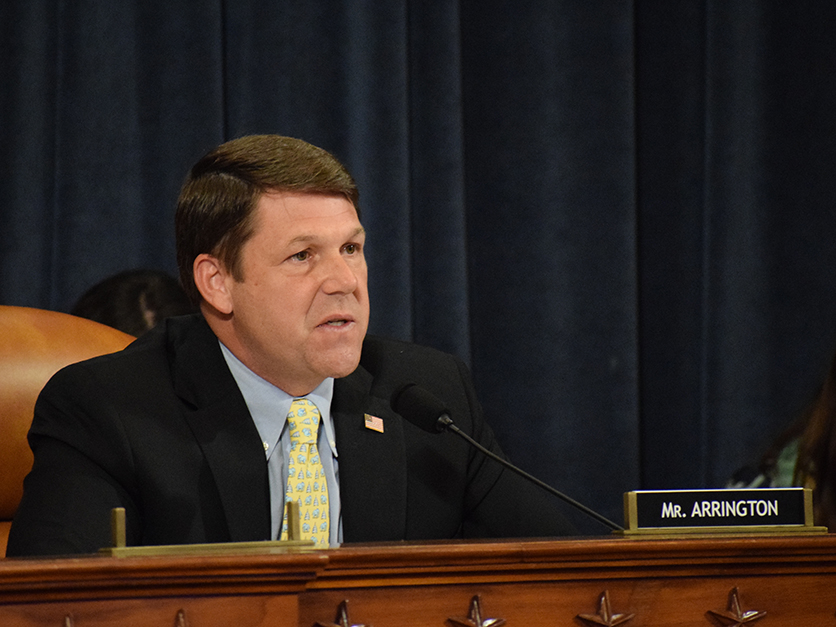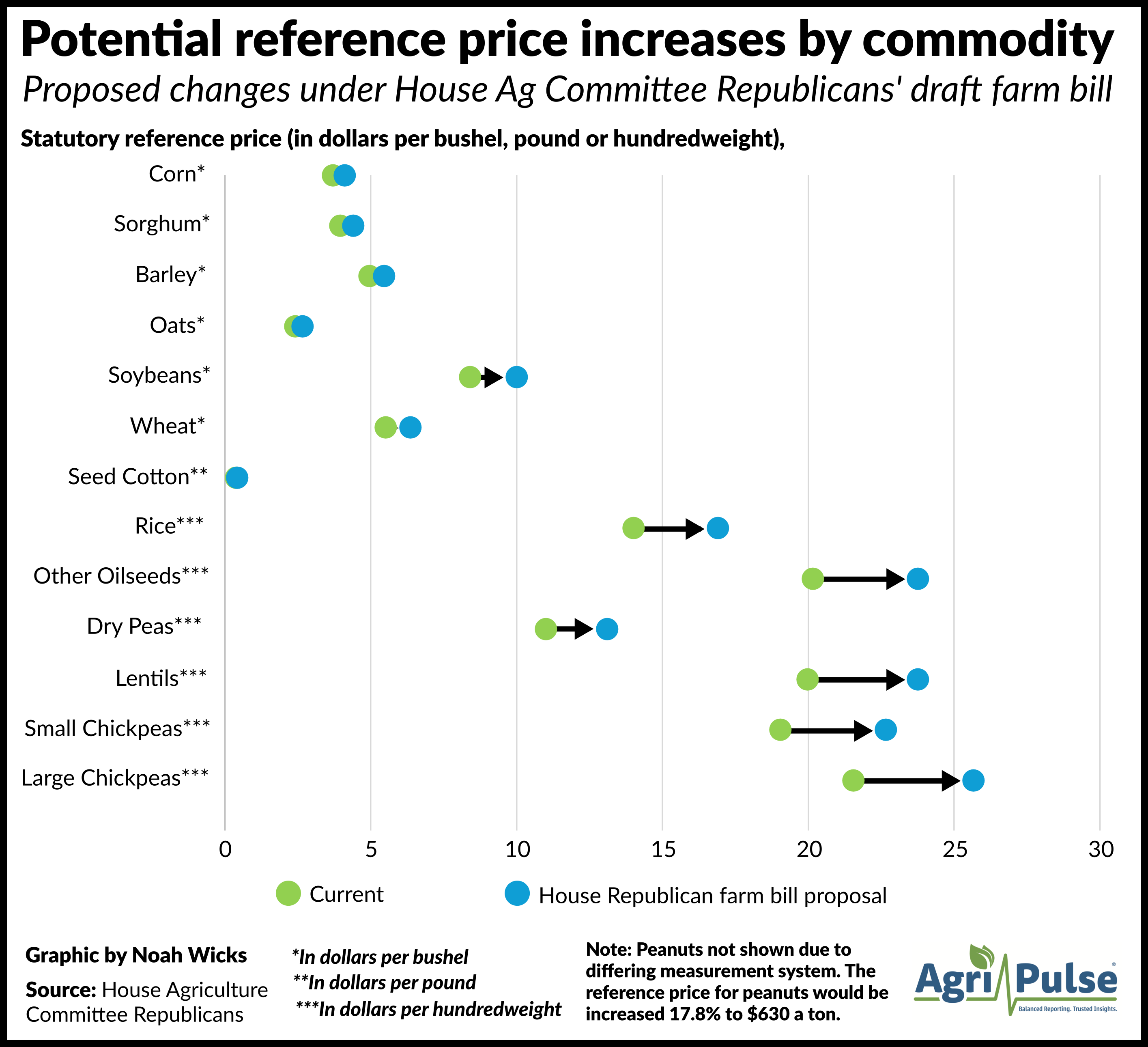Republicans on the House Agriculture Committee are proposing to spend more than $50 billion to shore up commodity programs and crop insurance, including a reference price increase of nearly 20% for soybean producers. But Republicans are still working with the Budget Committee chairman and congressional budget analysts on the method for covering the bill’s increased cost.
The 942-page bill, released Friday, would provide reference price increases for all row crops, with the rates varying depending on recent changes in markets and production costs.
The reference price for soybeans would go from $8.40 to $10 a bushel, an increase of more than 19%. The rate for corn would rise 10.8 % from $3.70 to $4.10 a bushel, although there is a cost-saving provision for corn that puts a floor under the PLC rate of $3.30 a bushel.
Wheat growers would get an increase of 15.5% from $5.50 to $6.35. The reference price for seed cotton would increase 13.5% from 37 cents a pound to 42 cents a pound. Rice’s reference price would jump 20.7% from $14 a hundredweight to $16.90. The rate for sorghum would go up 11.3% from $3.95 to $4.40 a bushel. The reference price for peanuts would be increased 17.8% to $630 a ton.
The bill also would increase marketing loan rates by 10% for most major commodities, including corn, soybeans, wheat, and allows for producers to obtain new base acres that are necessary to get payments under the Agriculture Risk Coverage and Price Loss Coverage programs.
The base update would be based on planted and prevented planting acreage from 2019 through 2023 and is expected to cost taxpayers $8 billion. If more than additional 30 million acres were eligible under the update, USDA would have to pro-rate the total. Up to 15% of a farm's acreage that is planted to non-covered crops such as fruits and vegetables or alfalfa could be eligible for PLC and ARC base.
To boost crop insurance coverage, the draft bill also would boost premium subsidies on the Supplemental Coverage Option from 65% to 80% and raise the top coverage level from 86% to 90%.
Budget chairman critical to funding commodity program expansion
But the increased spending for the commodity title and crop insurance program will leave the bill with a large gap in funding heading into the committee’s planned debate next Thursday. The gap would need to be filled before the bill could be considered on the House floor, and that’s where Budget Chairman Jodey Arrington, R-Texas, will be critical, according to both Republican and Democratic aides.
House Ag Committee Chairman Glenn "GT" Thompson, R-Pa., is relying on funding the commodity and crop insurance provisions by suspending USDA’s use of what is known as Section 5 spending authority through the Commodity Credit Corporation. The Congressional Budget Office, however, says that doing so would only save $8 billion over 10 years, less than 20% of what’s needed to pay for the increased farm bill spending, aides say.
Cut through the clutter! We deliver the news you need to stay informed about farm, food and rural issues. Sign up for a FREE month of Agri-Pulse here.
Thompson, however, believes that the CCC savings should be scored at $53 billion over 10 years, based on recent Section 5 spending history, and is looking to Arrington to work with CBO to increase its Section 5 savings estimate to $53 billion.
“I’m confident Chairman Arrington will do his best to correct the accuracy of CBO scoring. So that's what it comes down to. It's an accuracy issue … we're just having more accurate numbers to reflect the actual cost of the program," Thompson told Agri-Pulse.
Arrington, who represents one of the largest cotton-producing regions in the country, has incentive to help out Thompson, but he hasn’t said what he will do, and has used his chairmanship to decry the federal debt and the use of “budget gimmicks.”
The Section 5 authority proved to be a powerful trade weapon for then-President Donald Trump, whose administration used the CCC to compensate farmers for the impact of retaliatory tariffs imposed by China. The Trump administration also tapped the CCC during the COVID pandemic, and Agriculture Secretary Tom Vilsack has made extensive use of the spending authority since taking office in 2021, including by using $3 billion in CCC funding to set up the Partnerships for Climate-Smart Commodities initiative.
Aides say USDA has spent an average of $10.7 billion a year through Section 5 over the past six years.
A Thompson aide brushed off concerns that a second Trump administration wouldn't be able to use the CCC as a trade war tool, if the Section 5 authority is unavailable to him. Trump is talking about imposing significant new tariffs not just on imports from China but from all other countries as well.
“We think that the CCC has been used as a Get Out of Jail Free card for a trade war. And we believe that by turning off that authority, it will require a national strategy and plan about what to do in the wake of increased tariffs, and that will require a conversation with Congress about what that response would look like,” the staffer said.
Some nutrition funding will pay for trade promotion boost
Thompson is trying to persuade some Democrats to vote for the bill, but it also relies on shifting money from the nutrition title to pay for other priorities in the legislation, including a doubling of funding for trade promotion programs and funding increases for specialty crops, aides say.
The bill would restrict how USDA conducts future reviews of the Thrifty Food Plan, an economic model of food costs that is used to keep Supplemental Nutrition Assistance Program benefits up to date with eating patterns and dietary guidance.
The restrictions would save $27 billion, according to another GOP staffer. About $12 billion to $16 billion of that will be kept in the nutrition title. The rest will be moved to three other titles, trade, horticulture and research. A significant portion will go to doubling funding for the Market Access Program and Foreign Market Development Program, which both fund commodity groups that are seeking to increase exports.
All of the SNAP savings are being kept in programs within the jurisdiction of the Nutrition, Foreign Agriculture and Horticulture Subcommittee, the staff member said.
The top Democrat on House Ag, David Scott of Georgia, criticized the draft bill in a statement citing the SNAP and CCC provisions as well as bill's removal of climate guardrails on Inflation Reduction Act conservation funding.
“The Republican plan to eliminate the agriculture secretary’s CCC discretionary authority would tie the hands of our government to assist farmers during natural disasters and pandemics," Scott said. "The funding proposal that the chairman has put forward does a disservice to American agriculture because it doesn’t provide a path forward to getting a bill passed on the House floor."
Senate Agriculture Committee Chairwoman Debbie Stabenow, D-Mich., issued a statement reiterating her criticism of using SNAP and CCC to pay for the bill's cost. She also alluded to the funding gap in the draft measure.
“I remain deeply concerned that his proposal will split the broad, bipartisan coalition that has always been the foundation of a successful farm bill," she said. "It makes significant cuts to the family safety net that millions of Americans rely on, and it blocks USDA’s ability to provide real time assistance to farmers through the CCC to address emerging challenges. Even with these shortsighted cuts, it is unclear to me how they will pay for their proposal."
Download the bill text here.
A chart of reference prices is here.
A chart of marketing loan rates is here.
For more news, go to Agri-Pulse.com.




